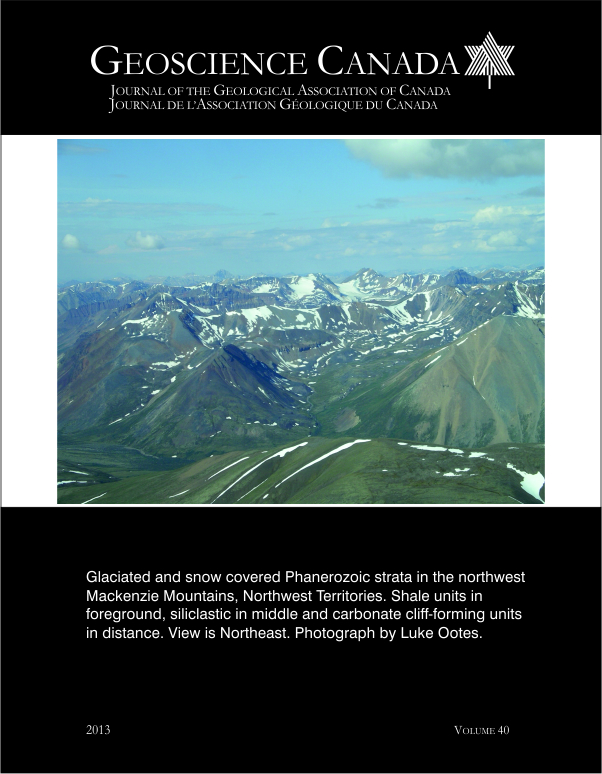Published 2013-08-24
How to Cite
Abstract
The Birchy Complex of the Baie Verte Peninsula, northwestern Newfoundland, comprises an assemblage of mafic schist, ultramafic rocks, and metasedimentary rocks that are structurally sandwiched between overlying ca. 490 Ma ophiolite massifs of the Baie Verte oceanic tract and underlying metasedimentary rocks of the Fleur de Lys Supergroup of the Appalachian Humber margin. Birchy Complex gabbro yielded a Late Ediacaran U–Pb zircon ID–TIMS age of 558.3 ± 0.7 Ma, whereas gabbro and an intermediate tuffaceous schist yielded LA–ICPMS concordia zircon ages of 564 ± 7.5 Ma and 556 ± 4 Ma, respectively. These ages overlap the last phase of rift-related magmatism observed along the Humber margin of the northern Appalachians (565–550 Ma). The associated ultramafic rocks were exhumed by the Late Ediacaran and shed detritus into the interleaved sedimentary rocks. Psammite in the overlying Flat Point Formation yielded a detrital zircon population typical of the Laurentian Humber margin in the northern Appalachians. Age relationships and characteristics of the Birchy Complex and adjacent Rattling Brook Group suggest that the ultramafic rocks represent slices of continental lithospheric mantle exhumed onto the seafloor shortly before or coeval with magmatic accretion of mid-ocean ridge basalt-like mafic rocks. Hence, they represent the remnants of an ocean – continent transition zone formed during hyperextension of the Humber margin prior to establishment of a mid-ocean ridge farther outboard in the Iapetus Ocean. We propose that microcontinents such as Dashwoods and the Rattling Brook Group formed as a hanging wall block and an extensional crustal allochthon, respectively, analogous to the isolation of the Briançonnais block during the opening of the Alpine Ligurian–Piemonte and Valais oceanic seaways.
SOMMAIRELe complexe de Birchy de la péninsule de Baie Verte, dans le nord-ouest de Terre-Neuve, est constitué d’un assemblage de schistes mafiques, de roches ultramafiques et de métasédiments qui sont coincés entre des massifs ophiolitiques d’ascendance océanique de la Baie Verte au-dessus, et des métasédiments du Supergroupe de Fleur de Lys de la marge de Humber des Appalaches en-dessous. Le complexe de gabbro de Birchy a donné une datation U-Pb sur zircon ID-TIMS correspondant à la fin de l’Édiacarien, soit 558,3 ± 0,7 Ma, alors qu’un gabbro et un schiste tufacé intermédiaire montrent une datation LA-ICP-MS Concordia sur zircon de 564 ± 7,5 Ma et 556 ± 4 Ma, respectivement. Ces datations chevauchent la dernière phase de magmatisme de rift observée le long de la marge Humber des Appalaches du Nord (565-550 Ma). Les roches ultramafiques associées ont été exhumées vers la fin de l’Édiacarien et leurs débris ont été imbriqués dans des roches sédimentaires. Les psammites de la Formation de Flat Point susjacente ont donné une population de zircons détritiques typique de la marge laurentienne de Humber des Appalaches du Nord. Les relations chronologiques et les caractéristiques du complexe de Birchy et du groupe de Rattling Brook adjacent, permettent de penser que ces roches ultramafiques pourraient être des écailles de manteau lithosphérique continental qui auraient été exhumées sur le plancher océanique peu avant ou en même temps que l’accrétion magmatique de roches mafiques basaltiques de type dorsale médio-océanique. Par conséquent, elles seraient des vestiges d’une zone de transition océan-continent formée au cours de l’hyper-extension de la marge de Humber avant l’apparition d’une dorsale médio-océanique plus loin au large dans l’océan Iapétus. Nous proposons que des microcontinents comme de Dashwoods et du groupe de Rattling Brook ont constitués respectivement un bloc de toit et un allochtone crustal d’extension, de la même manière que le bloc Briançonnais a été isolé lors de l’ouverture des bras océaniques alpins de Ligurie-Piémont et de Valais.
